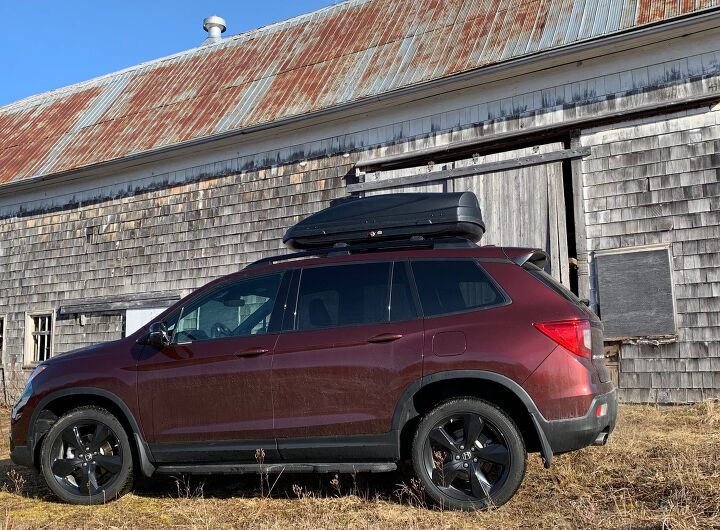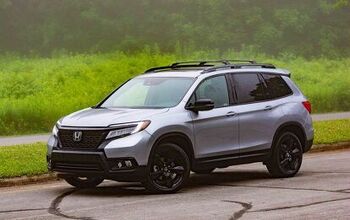2019 Honda Passport Review - Slightly Surly

There always seems to be room for one more at the SUV and crossover table, regardless of marque. Witness mighty Mercedes-Benz, a company filling every niche and crevasse in its lineup with an ever-expanding portfolio of high-riding wagons. When the late Alfred Sloan posited a vehicle for every purse and purpose, this is hardly what the man had in mind.
It is where we are, however, and automakers are only too glad to serve up an ever wider buffet of all-wheel drive options. Honda, for its part, has been surprisingly recalcitrant in the SUV onslaught, soldiering on for years with simply the CR-V and Pilot. It took a relative age for the HR-V to appear and, along the way, the offbeat Accord Crosstour came and went.
That “H” badge carries a lot of weight, so you knew Soichiro’s Dream was eventually going to produce a two-row SUV with off-road pretensions and a lot of familiar Honda feel. Given all this, one thing is certain: the 2019 Honda Passport is going find buyers. A lot of them.
Some shoppers will buy it simply because “it’s a Honda.” Those customers will not be disappointed because, from the B-pillar forward, the Passport has much in common with the other SUV and SUV-like machines with which it shares a showroom. Inside, the dashboard layout, arrangement of major controls – all of it, really – will be instantly familiar to anyone who’s set foot in a modern day SUV or minivan from the company.
It’s a safe bet on Honda’s part one which is likely to pay off. There are subtle differences to the Passport’s interior, ones which are carefully curated to give the impression that the Passport is a slightly more rugged than its brothers. The twin rocker switches controlling cabin temperature, for example, transmit a satisfying click when pressed and are covered in what feels like a hearty swath of rubber coating. A sliding cover for the centre console, one which conveniently retracts like a rolltop desk rather than rise upward like most covers do, slides back and forth like egesta through waterfowl. Armrests attached to the inboard edges of the driver and passenger seat present an extra degree of comfort and operate like those found on some pickup trucks. Generous door pockets stand ready to swallow water bottles and the wayward detritus of life.
Get the picture? Honda has subtly imbued the Passport with an air of “lifestyle readiness” not found in its Pilot brother. This carries through to the rig’s exterior, where the two-row rig bears a blackout front treatment and twin lights tucked in the lower corners of its front bumper. That latter feature works to give the Passport a more rugged appearance, as if your math teacher donned a pair of hiking boots and an L.L. Bean jacket. You know, underneath, he’s the same mild-mannered guy … but at least he looks ready for adventure.
Compared to the Pilot, this all-wheel drive Passport does indeed have an extra measure of off-road readiness, endowed as it is with 8.1 inches of ground clearance compared to 7.3 inches for the Pilot. Front-drive Passports have but 7.3 inches. All of these two-row Hondas are trimmed with cladding over their wheel arches in yet another bit of visual chicanery in terms of its actual height.
Thanks to fortuitous timing, this machine landed in my driveway just as a Ford Edge was departing. It is likely that some customers will cross-shop these two, so some comparison is apt. Despite what it may say on paper, the Passport has far more real-world rear-seat legroom than the Edge. Its front chairs are more comfortable, too, with longer cushions providing more leg support for those of us who are long of limb. The aforementioned seat-mounted armrest add a dose of individual comfort and smart storage touches appear throughout the cabin, making the most of interior space and cargo area. Behind its second-row of seats, this new crossover can carry 41.2 cubic feet of kit.
There are a few missteps. Wireless device charging only appears on top-rung trims, which is a total rip-off in a world where that technology shows up on a Toyota Corolla Hatchback. While the company has re-added a volume button to the infotainment system (thank you) it would still benefit from a dedicated tuning knob. And Honda needs to incorporate an electric parking brake in order to ditch the weirdly contoured and shin bashing pump-n-dump lever.
Honda Sensing safety technology is included on all Passports, endowing the vehicle with lane-keeping tools and adaptive cruise along with braking assists and forward collision warnings. Tri-zone climate control is standard in every trim as well.
A single engine option is offered in the form of a 24-valve 3.5-liter V6 producing 280 horsepower and 262 lb-ft of torque, a mill which mercifully makes those numbers on regular gas. All versions come equipped with Honda’s dandy nine-speed automatic, marking a departure from its Pilot cousin in which that desirable ‘box only appears on the most expensive trims. In a week’s testing, we learned to ignore the green Econ button tucked to the left of the steering wheel, as it only served to neuter throttle response. Absent of that, the Passport was more than lively enough for its intended demographic. The all-wheel drive system worked invisibly on slick pavement.
Is Passport cannibalizing Pilot sales? At this point, it’s hard to say. Last month, the Pilot sold roughly the same number of copies as it did in April 2018, while the new Passport added nearly 3,000 sales. Through the first four months of this year, however, the three-row Pilot shed 5,368 units while the two-row Passport added 7,721. That’s still a net increase, but we’ll be keeping an eye on these numbers as the calendar year progresses.
Honda made an interesting choice in pricing the two-row Passport. Its starting price is $540 more than the three-row Pilot, proving that the allure of hiking boots and an L.L. Bean jacket can command some extra cash. In America, the Passport’s pricing rips all the way to $43,680 for a top-tier Elite model, while the most expensive Pilot is priced at $48,020. There is an excellent chance that the average transaction price of the three-row rig will be more than the two-row unit, but the prices of entry are very telling as to what Honda thinks it can get away with in this market. Buying advice? Stick with the entry-level Sport model as it serves up a healthy level of standard kit and the same powertrain combo as its more expensive brothers. All-wheel drive is at your discretion.
Like it or not – and dealers will like it a lot – Honda has set out another place setting at its SUV and crossover table. With a familiar yet slightly more rugged face, this two-row machine will prove popular with existing Honda owners looking to trade up to something new and should draw new customers to the brand, such as math teachers looking for a slightly surly crossover to go with their new hiking boots.
[Images: Matthew Guy/TTAC]

Matthew buys, sells, fixes, & races cars. As a human index of auto & auction knowledge, he is fond of making money and offering loud opinions.
More by Matthew Guy
Latest Car Reviews
Read moreLatest Product Reviews
Read moreRecent Comments
- Probert They already have hybrids, but these won't ever be them as they are built on the modular E-GMP skateboard.
- Justin You guys still looking for that sportbak? I just saw one on the Facebook marketplace in Arizona
- 28-Cars-Later I cannot remember what happens now, but there are whiteblocks in this period which develop a "tick" like sound which indicates they are toast (maybe head gasket?). Ten or so years ago I looked at an '03 or '04 S60 (I forget why) and I brought my Volvo indy along to tell me if it was worth my time - it ticked and that's when I learned this. This XC90 is probably worth about $300 as it sits, not kidding, and it will cost you conservatively $2500 for an engine swap (all the ones I see on car-part.com have north of 130K miles starting at $1,100 and that's not including freight to a shop, shop labor, other internals to do such as timing belt while engine out etc).
- 28-Cars-Later Ford reported it lost $132,000 for each of its 10,000 electric vehicles sold in the first quarter of 2024, according to CNN. The sales were down 20 percent from the first quarter of 2023 and would “drag down earnings for the company overall.”The losses include “hundreds of millions being spent on research and development of the next generation of EVs for Ford. Those investments are years away from paying off.” [if they ever are recouped] Ford is the only major carmaker breaking out EV numbers by themselves. But other marques likely suffer similar losses. https://www.zerohedge.com/political/fords-120000-loss-vehicle-shows-california-ev-goals-are-impossible Given these facts, how did Tesla ever produce anything in volume let alone profit?
- AZFelix Let's forego all of this dilly-dallying with autonomous cars and cut right to the chase and the only real solution.








































Comments
Join the conversation
I'm in the market for this vehicle. I have a 2004 Element, in excellent west-coast condition, and a 2010 Fit, the same, looking to downsize to one vehicle that can handle all efficiently. But something is missing here. Where is the plug-in hybrid 4-cylinder version? Or an all electric? Only a V-6? I'll wait, thank you.
Matthew Base Sport trim feels so cheap. For that money they couldn't make a leather wrapped steering wheel. haha. + remember... timing belt spells into $1000 down the road.